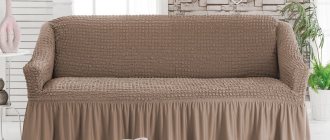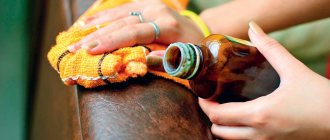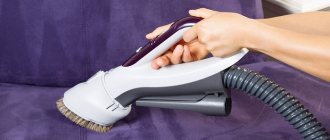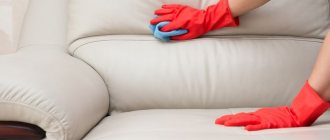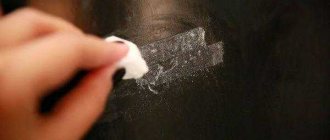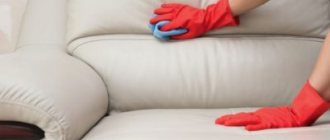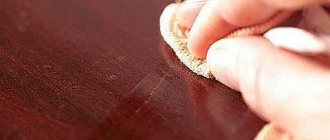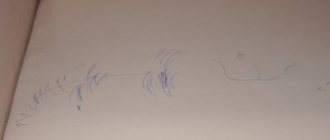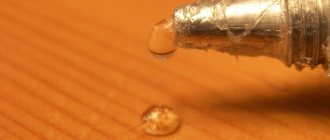The concept of cuisine came to us from the Germans in the era of Peter I. Previously in Rus' it was called a concoction or a cook. Modern kitchens can occupy a separate room or be combined with a dining room.
In the kitchen, food is prepared and food is stored. It is usually equipped with a sink, cutting tables, a stove, an oven, a microwave oven, cabinets for storing kitchen utensils, a refrigerator for preserving prepared dishes and storing raw food.
Many people in modern kitchens install dishwashers for washing dishes, under the wall cabinet above the range hoods, the purpose of which is to clean the air from combustion products, unpleasant odors, and fumes. But no matter how hard we try, cooking is always associated with contaminants that settle on kitchen furniture, walls, ceilings, forming grease deposits, and when using gas stoves, burning.
Recommendations before you start cleaning the kitchen
Before you start cleaning it, you need to find out what materials the kitchen furniture is made from. Wooden kitchens come unpainted and coated with a layer of paint, with plastic facades made of MDF and chipboard, varnished or laminated. But no matter what material is used to prepare kitchen furniture, before you start cleaning it, you should test the detergent to see if it reacts with the surface of the furniture somewhere in an inconspicuous corner. A small-sized surface treated with a cleaning agent is first allowed to dry, then the extent to which its color, shine, and general appearance has changed is determined.
During cooking, fat evaporates along with tiny droplets of water, which deposits a coating on the walls, ceiling, furniture, and other kitchen surfaces. If it is not removed in time, it is absorbed deeper into all surfaces and becomes old. To wash away grease deposits, you need to make a lot of effort. Therefore, general cleaning of all kitchen surfaces must be carried out at least once a year, and preferably twice.
How to clean grease from kitchen utensils at home
Keeping the kitchen clean is one of the main tasks of housewives, so the question of how to clean grease from kitchen furniture at home is always relevant. Home and professional remedies will help clean surfaces and restore their freshness. However, in order not to damage the headset, it is important to know what material it is made of and take into account the features of caring for it.
The article contains useful tips and effective methods that will help remove grease from glossy, plastic and wooden furniture in the kitchen.
Cleaning kitchen surfaces with different coatings
Kitchen furniture made from natural wood requires special delicacy. For cleaning, you cannot use household chemicals, which are based on alkali, which copes well with grease and other contaminants, but corrodes wood. Folk remedies containing peroxide, ammonia, and citric acid are also not suitable for cleansing it.
For kitchens made of natural wood, special products with a neutral pH are more suitable. A soap solution and liquids intended for caring for dishes, diluted with water in a ratio of 1 to 20, wash off grease and dirt well from wooden surfaces. To apply the composition to the surface, it is most convenient to use a spray bottle. In order not to harm the wood, movements should be directed along the grain.
Before applying cleaning products, the surface is moistened with plain water using the same spray bottle. This speeds up the reaction and makes cleansing easier. If you decide to moisten with a cloth, you must wring it out well so that excess moisture does not harm the wooden surfaces. Having finished cleaning, all surfaces must be treated with polish, a protective layer of oil or wax.
Cleaning polished furniture
Polished furniture gained popularity in the middle of the last century. At the same time, housewives were faced with the problem of how to clean its smooth and shiny surface. Folk remedies are varied and sophisticated, but they give an amazing effect. It is necessary to learn two rules: polishing cannot be wiped with a wet cloth, varnished surfaces do not tolerate soap solutions. This knowledge allows you to maintain the original shine and prevent dulling of wooden structures.
Any of these methods allows you to rid furniture of stains quickly and effectively. At the same time, the polish remains shiny and does not fade over time.
Soda-oil mixture for wooden surfaces
For wooden kitchens with unpainted surfaces, but coated with various impregnations such as varnish, oil, wax, a mixture of vegetable oil (1 tablespoon) with soda (1.5 tablespoons) is suitable. The resulting mixture is applied in an even layer to the contaminated surface. Be prepared for the fact that some of the soda will crumble, but the oil, absorbed into the wood, literally immediately makes it cleaner, adding a little brightness. All that remains is to remove the remaining soda with a soft, slightly moistened cloth.
It is recommended to clean kitchen furniture at least once every 60 days. The unpleasant aspect of the soda-oil solution is that the light surface of kitchens can acquire a yellowish tint. The positive side is that the mixture not only copes with old stains of grease and soot deposits, but also protects the wooden surface from dirt and water absorption, clogging its pores.
Removing grease stains and dirt with vinegar solution
A solution of warm water and vinegar in equal proportions is suitable for any surface except natural wood. Warm vinegar water can be applied to the contaminated surface with a sponge or spray bottle. After cleaning the surface from dirt, wipe it with a dampened, then dry soft cloth. You should not clean kitchen furniture more often than once a quarter.
Warning
When starting to clean furniture, carefully read the instructions to make sure for which surfaces the product is intended.
Always test the effect of the drug on a small area that is hidden from view, so that if it fails, the appearance will not be damaged. Only after such a test can you begin to clean the item.
For polished furniture, do not wipe with a damp cloth, as this will dull the shine of the surface.
Do not use abrasive brushes or sponges that will damage the wood surface. The desire to clean dirt from furniture can quickly result in material damage. Try to avoid excessive moisture in wood flooring.
Vinegar with isopropyl alcohol for deep cleaning
A solution of 6 percent vinegar with isopropyl alcohol helps to cope with difficult stains on painted and unpainted wooden surfaces. It is also suitable for removing old grease stains, dirt and grime from worktops, plastic facades of fibreboard and chipboard, varnished surfaces, cladding films and tiles.
To prepare the solution, take 7 parts of 6 percent vinegar and 1 part of isopropyl alcohol, which can be purchased at stores selling consumables for office equipment, and a couple of drops of liquid detergent. Using a napkin soaked in the solution, wipe all contaminated areas of the furniture. The mixture is then removed with warm water, and the surface of the cabinets is rubbed with polish or, in the case of wood, wax. This, for some time, will protect the surface of the kitchen furniture from repeated contamination and moisture penetration.
Method 1. Scheduled weekly cleaning
1
Prepare a vinegar-based solution. Mix a cup of cooking vinegar with a cup of warm tap water. Such a gentle natural solution can renew solid kitchen facades beyond recognition. It will not damage the paintwork or the natural wood base. If you can't stand the strong smell of vinegar, you can try using a gentle soap solution, or, even more effective, a dishwashing detergent (grease-breaking) solution. To do this, mix a teaspoon of dishwashing detergent (Fary, Drop, etc.) in a cup of warm tap water. Under no circumstances should you use universal cleaning products for kitchen and other interior surfaces to clean solid wood facades. With their bioactive ingredients, they can cause irreparable damage to the paintwork and tinting of kitchen facades.
2
After several days of active use of the stove, wipe the facades. Dirt and food particles can settle on the fronts of kitchen cabinets after each time you prepare food. If you are not lazy and start wiping the surface of your kitchen doors, your furniture will retain the presentable appearance it had when you purchased it. Dip a piece of soft cloth into the solution, wring it thoroughly to remove excess liquid and then gently wipe the fronts and bottoms of kitchen wall cabinets. If you leave drops of moisture from the solution on the surfaces, they will do you more harm than good. The cloth with which you wipe the kitchen surface should be damp, but under no circumstances wet! If you wipe the surface of the facades with a vinegar solution, the unpleasant vinegar smell will disappear from the kitchen after briefly airing the room, after the treated surfaces have completely dried.
3
Wipe the fronts and finished surfaces of kitchen cabinets with a clean, dry cloth. To ensure that an active vinegar or soap solution removes dirt from surfaces without causing harm or leaving streaks, wipe the surfaces with a dry, clean cloth.
4
Periodically clean not only the outside surfaces, but also the inside of your kitchen cabinets. Spices and various food additives that are stored in our kitchen cabinets often spill out and stain the shelves, so you should periodically, at least once every two weeks, clean the inside of the cabinets. Remove all jars and packaging that you keep in your cabinets. First, sweep away all the dirt with a soft brush, then wipe the shelves with a mild vinegar or soap solution. Then dry the cabinets with a clean towel. Now you can return all the kitchen utensils that you took out while cleaning to their place. If you have to clean up a lot of spilled food additives and spices in your cabinets, you may want to invest in airtight containers or containers made of plastic or glass to store them more carefully. Moreover, airtight containers with rubber seals will protect food, nuts and spices from food moths and cockroaches. To continue to keep the inside of your custom kitchen cabinets clean, you can place rubber mats on the shelves, which are sold in furniture hardware stores. To maintain cleanliness and order, it is enough to simply and carefully remove these rugs, wash and dry them, and then return them to their original place.
5
Wipe dust from solid wood facades and cabinets at least once a week. To prevent dust from accumulating on the facades and body of kitchen cabinets, and without having to resort to thorough cleaning, wipe vulnerable surfaces with a soft, dry cloth. As they say, a disease is easier to prevent than to treat - this axiom also applies to maintaining cleanliness in your favorite corner of the house.
Ammonia
A good product for cleaning kitchen surfaces is ammonia, diluted with warm water in proportions of 1 to 1. You just need to use it with caution, no more than once a quarter, and do not apply it to wooden furniture. The liquid is applied to the surface using a spray bottle or foam sponge. Then a cloth moistened with water comes into play. The final stage is wiping with a dry cloth.
No. 15. Melamine sponge
Melamine sponge – know-how in the field of home care. It looks like an ordinary sponge; it compresses well and feels like rubber to the touch. It works the same way as an eraser on a pencil. Using a melamine sponge, you can remove traces of markers, felt-tip pens, and some other types of dirt from surfaces. Gradually, the sponge wears off, just like the eraser. The material is absolutely safe and harmless, in most cases it can replace detergent.
Hydrogen peroxide with water
Hydrogen peroxide is used in the form of an aqueous solution, 1 part peroxide to 2 parts water. This mixture is intended for MDF and chipboard boards. For wooden surfaces it is used only to remove mold. The product not only effectively fights grease and other contaminants, but also helps disinfect surfaces. You can treat contaminated areas with a spray bottle or using a soft rag as they become dirty.
Features of washing walls
Often, grease ends up not only on furniture located near the cooking area, but also on the walls. The process of cleaning them depends on what kind of coating they have:
- Tiles - almost any product that will not cause mechanical damage (scratches when washed) will do;
- Paint – all products that do not contain alcohol or solvents are acceptable;
- Wallpaper - only dry contact is allowed (with a regular rag or sponge) for paper, and for vinyl or non-woven wallpaper you can use “soft” products;
- Whitewashing – it is advisable to use dry cleaning only.

